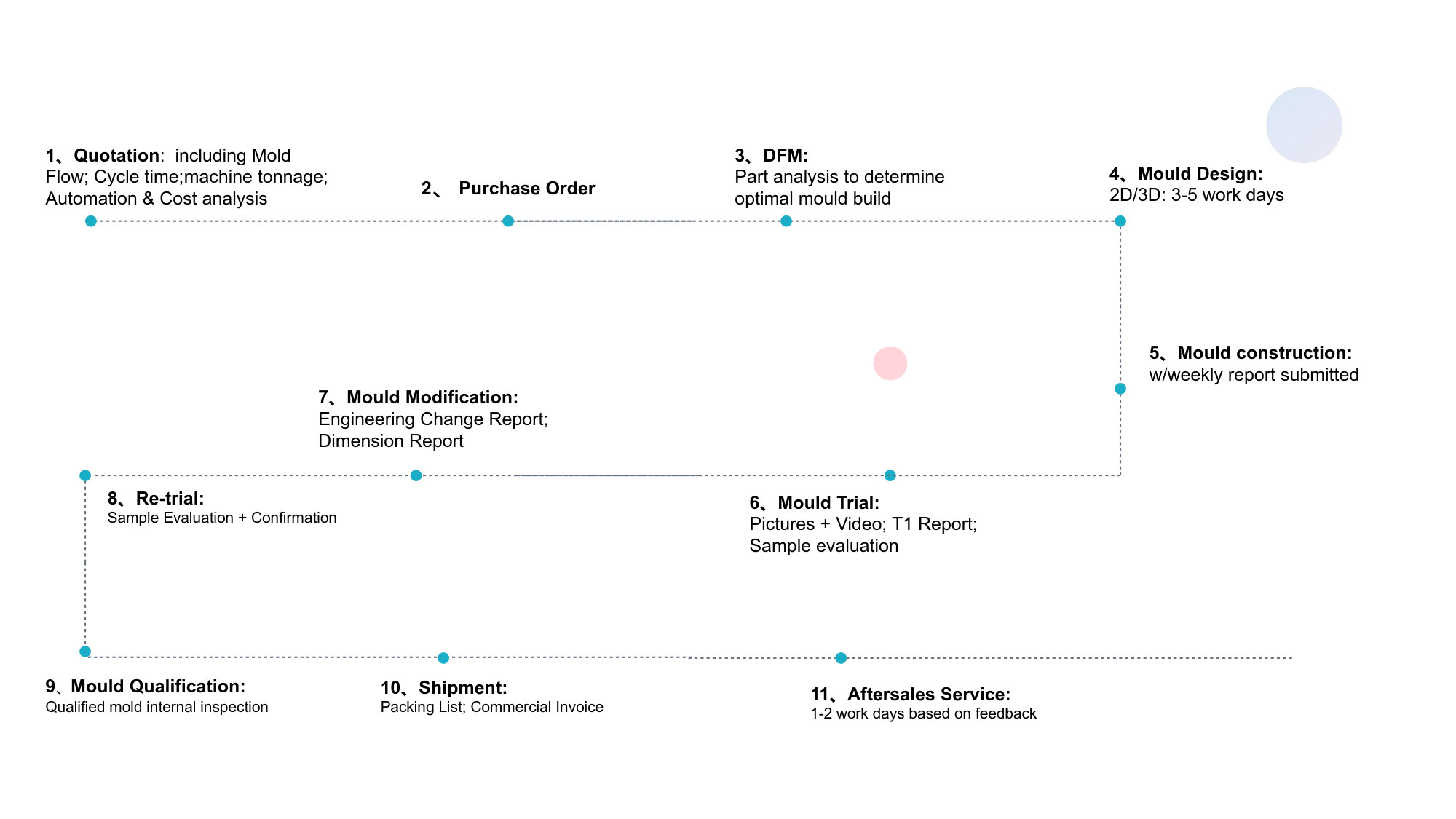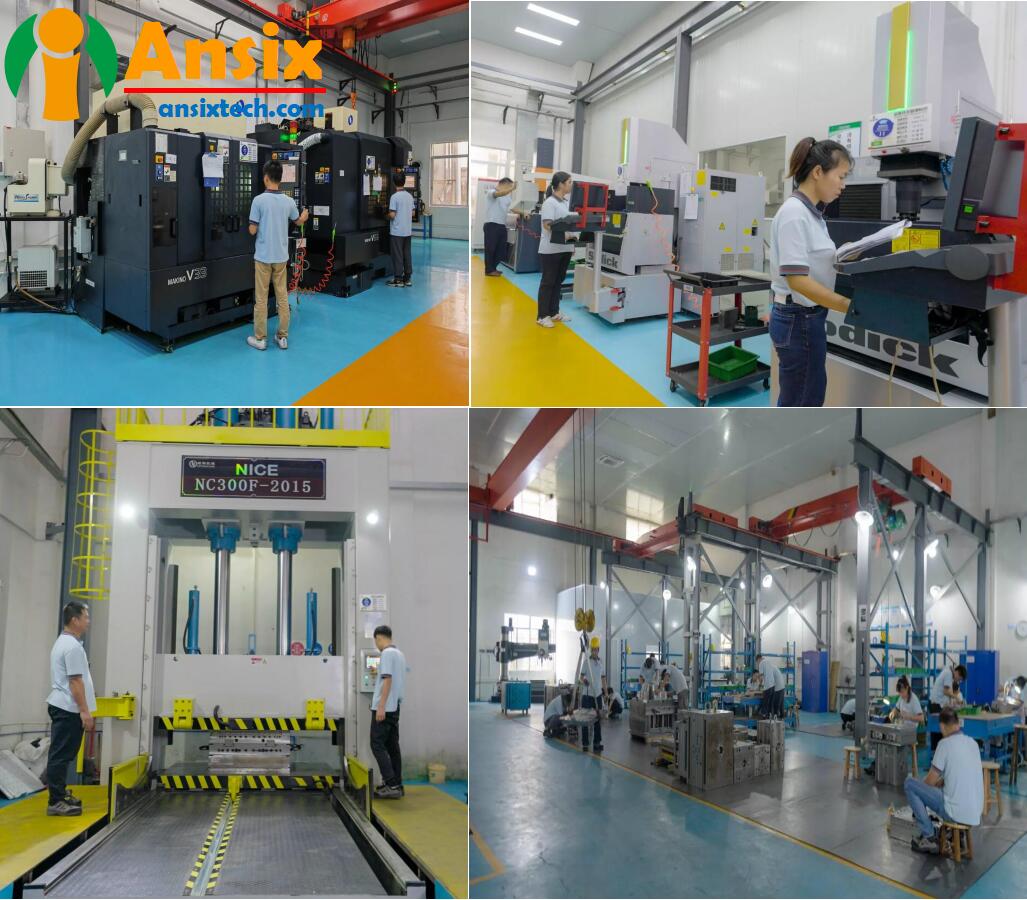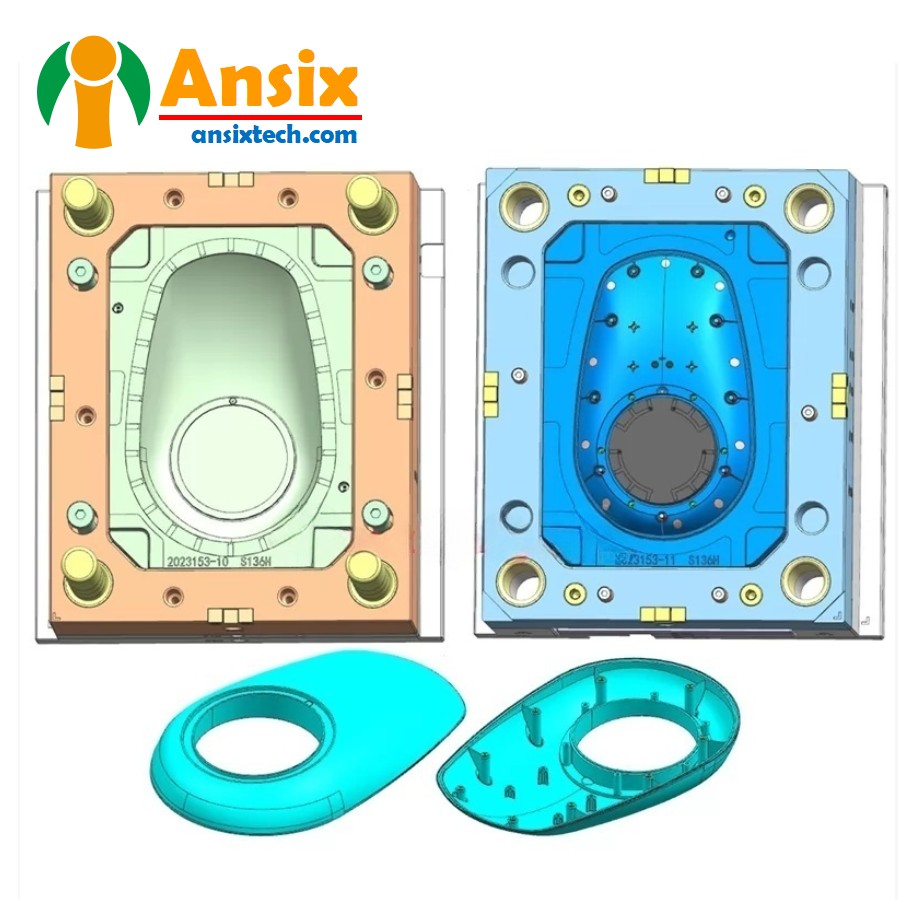New Energy Electric Vehicle Charging Wall-Mounted Pile Cover TPE Injection Mold
FEATURES
- The process flow of TPE injection mold for new energy electric vehicle charging wall-mounted pile cover is as follows
Design mold: Design the mold according to the design requirements and specifications of the charging wall-mounted pile cover. Taking into account the characteristics of TPE materials, it is necessary to design appropriate mold structures, mold cavities and cooling systems.
Material preparation: Select materials suitable for injection molding TPE and prepare the required mold materials, such as steel.
Processing of molds: Processing and manufacturing of molds according to design drawings. This includes CNC machining, EDM, wire cutting and other processes.
Assemble the mold: Assemble the processed mold parts, including the mold cavity, cooling system, exhaust system, etc.
Debugging and testing: Debugging and testing the assembled mold to ensure the normal operation of the mold and the quality of injection molding.
Prepare TPE material: Heat the TPE material to the appropriate temperature so that it becomes a molten state.
Injection molding: Inject the molten TPE material into the mold cavity. Through the pressure and temperature control of the injection molding machine, the TPE fully fills the mold cavity and solidifies during the cooling process.
Open the mold and take out the injection molded parts: After the injection molded parts have cooled and solidified, open the mold and take out the injection molded parts.
Inspection and trimming: Inspect injection molded parts to check size, appearance and quality, etc. Trim and post-process if necessary.
Maintenance and maintenance: Regular maintenance and upkeep of injection molds, including cleaning, lubrication, replacement of worn parts, etc., to ensure long-term use of the mold.
In the manufacturing process of TPE injection mold for new energy electric vehicle charging wall-mounted pile cover, it is necessary to pay attention to the characteristics of TPE materials, such as elasticity, softness and wear resistance. At the same time, it is also necessary to rationally design the mold structure and cooling system according to the requirements of the TPE injection molding process to improve the quality and production efficiency of injection molded parts. Please send us a message(Email: info@ansixtech.com ) at any time and our team will reply to you within 12 hours.
-
Mold Description
Product Materials:
TEP
Mold Material:
738H
Number of Cavities:
1*1
Glue Feeding Method:
Hot runner
Cooling Method:
Water cooling
Molding Cycle
44.5s

- Mold flow analysis and mold design of household portable outdoor charging piles for electric new energy vehiclesMold flow analysis and mold design of household portable outdoor charging piles for electric new energy vehicles are very important links, which directly affect the quality and production efficiency of the product. Here are some areas that may be covered in general:Mold flow analysis:Filling simulation: By simulating the filling process of melt in the mold cavity, parameters such as filling time, filling pressure, and filling speed are evaluated to predict possible defects such as poor filling, bubbles, and short injections.Cooling simulation: By simulating the cooling process of the melt in the mold, parameters such as cooling time, temperature distribution and shrinkage are evaluated to predict possible defects such as thermal stress, deformation and uneven shrinkage.Pressure loss simulation: By simulating the flow resistance of the melt in the mold, the flow performance of the melt in the mold is evaluated to predict possible defects such as poor melt flow and thermal flow marks.Mold design:Structural design: Design the structure of the mold, including mold cavity, mold core, cooling system, etc., to ensure the molding quality and dimensional accuracy of the charging pile shell.Material selection: Select a suitable mold material, considering its mechanical properties, wear resistance, thermal conductivity and other factors.Cooling system design: Design a reasonable cooling system to ensure uniform cooling of the charging pile shell and reduce quality problems caused by uneven deformation and shrinkage.Mold processing and debugging: According to the mold design drawings, the processing, manufacturing, assembly and debugging of mold parts are carried out to ensure the performance and quality of the mold.


- The mold manufacturing process and product material selection of household portable outdoor charging piles for electric new energy vehiclesThe mold processing process and plastic material selection for household portable outdoor charging piles for electric new energy vehicles are very important. The following are some aspects that may be involved in general:Mold design: Design the structure and parts of the mold according to the structural characteristics and requirements of the charging pile shell. This includes the design of mold base plates, mold cavities, mold cores, cooling systems and other components.Material procurement: Select suitable mold materials, usually tool steel with high hardness, high strength and wear resistance. At the same time, the materials used to make the cooling system also need to be selected, usually materials with good thermal conductivity properties.Mold processing: Mold processing includes CNC machining, electric discharge machining, wire cutting processing, etc., and performs precision processing of mold parts. These processes ensure mold accuracy and consistency.Heat treatment: Heat treatment of mold parts, usually including quenching, tempering and other processes, to improve the hardness and wear resistance of the material.Assembly and debugging: Assemble and debug the mold parts to ensure the performance and accuracy of the mold. This includes work such as installing a cooling system and adjusting the size and structure of the mold.Mold trial: Carry out mold trial to check the processing accuracy and performance of the mold to ensure that the mold can meet production requirements.Plastic material selection and application:Engineering plastics: Engineering plastics with good mechanical properties, wear resistance and weather resistance are usually selected as materials for charging pile shells, such as polypropylene (PP), polystyrene (PS), polycarbonate (PC), etc. .Environmentally friendly materials: Considering environmental protection requirements, you can choose recyclable plastic materials, such as polyethylene (TPE), etc.
- Mass production and Quality controlof for household portable outdoor charging piles for electric new energy vehiclesFor the mass production, assembly process control, cost control, process quality assurance and transportation of household portable outdoor charging piles for electric new energy vehicles, the following are general control and assurance measures:Mass production:Production plan: Develop a reasonable production plan and conduct reasonable production scheduling according to market demand and production capacity.Automated production: Use automated assembly lines and production equipment to improve production efficiency and consistency.Quality control: Establish a full-process quality control system and conduct strict quality control on every link in the production process.Assembly process control:Standardized operations: Develop standardized assembly operation instructions to ensure the operating specifications and consistency of each process.Assembly inspection: Set up quality inspection points during the assembly process and conduct quality inspection on key processes and key components.Cost control:Material procurement: Cooperate with suppliers to reduce raw material procurement costs and ensure the quality and stable supply of raw materials.Production efficiency: Optimize the production process, improve production efficiency, and reduce production costs.Save energy: optimize equipment use, save energy consumption, and reduce production costs.Process quality assurance:Quality management system: Establish a complete quality management system, including the establishment of quality control points, the formulation of quality inspection standards, the traceability of quality records, etc.Continuous improvement: Continuously improve and optimize the production process to improve product consistency and stability.Transportation:Packaging protection: Properly designed product packaging to ensure that the product is not damaged during transportation.Logistics management: Establish an efficient logistics management system to ensure that products can be delivered to customers in a timely and safe manner.The above are some control and assurance measures that may be involved in general, but actual production and transportation require in-depth research and analysis based on specific product requirements and production processes. If you need more detailed information, it is recommended to consult our professional production management and quality management engineers.




